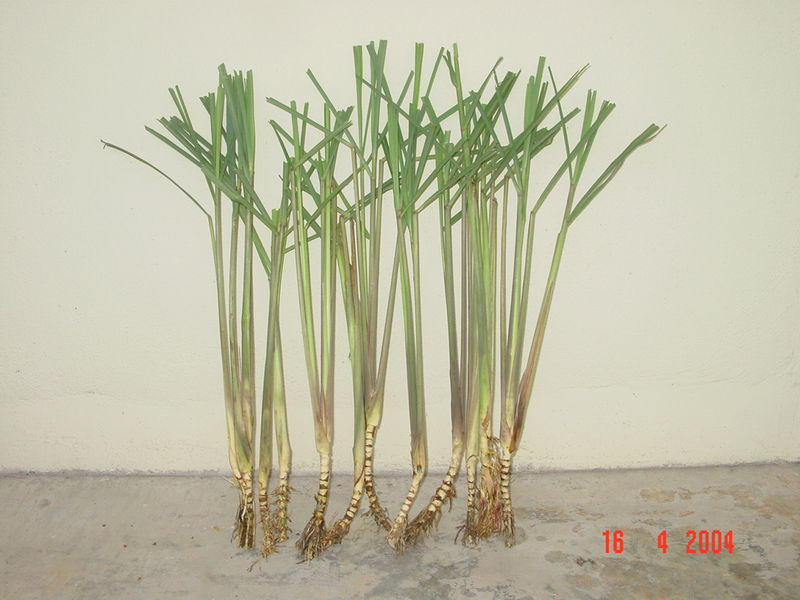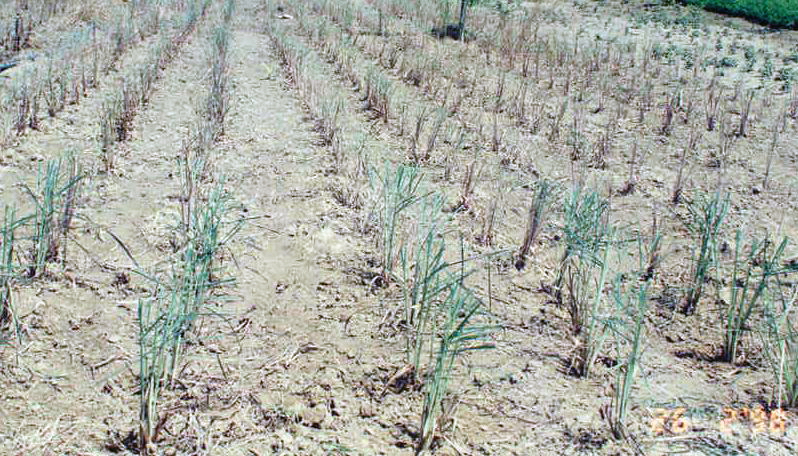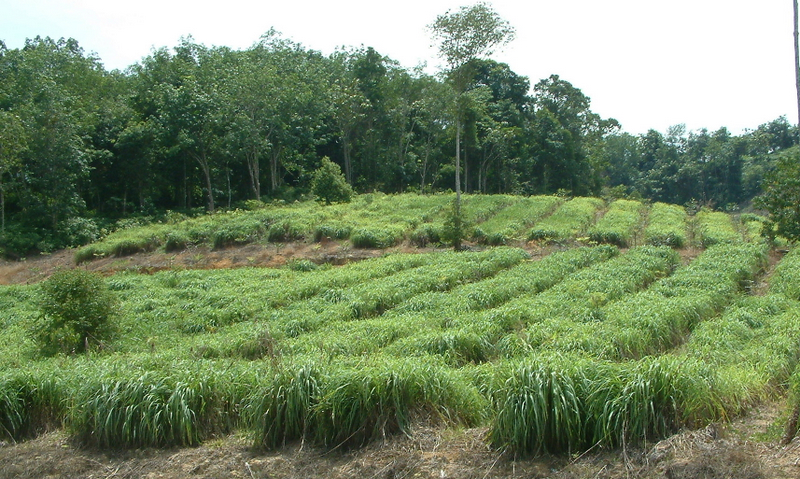Scientific Name
Cymbopogon nardus (L.) Rendle.
Synonyms
Andropogon citrosus Steud. [Invalid], Andropogon confertiflorus Steud., Andropogon grandis Nees ex Steud., Andropogon hamulatus Nees ex Steud., Andropogon khasianus (Hack.) Munro ex Duthie, Andropogon nardus L., Andropogon nardus var. confertiflorus (Steud.) Stapf ex Bor, Andropogon nardus subsp. grandis (Nees) Hack., Andropogon nardus var. luridus Hook.f., Andropogon nardus subsp. nilagiricus Hack., Andropogon nardus var. prolixus Stapf, Andropogon nardus var. validus Stapf, Andropogon nilagiricus Hochst. [Illegitimate], Andropogon pseudohirtus Steud., Andropogon thwaitesii Hook.f., Cymbopogon afronardus Stapf. [1]
Vernacular Name
| Malaysia | Serai wangi [3] |
| English | Blue citronella grass, Ceylon citronella, citronella, citronella grass, citronella oil grass, false citronella, Mana grass, nard grass, new citronella grass [2] |
| China | Ya xiang mao [3] |
| India | Afo, allapu kommu vellavanti gadda, allupu, bhotri, chora-pulla-enna, citronella aenna hullu, gand bel, ganda-hanchi-khaddi-yanne, gandhabael, ganjani, guchcha, haona, kaamaachipillu, kaamaakshipull, kamachi pillu, kaavattampullu, kamakshikasuvu, kommu, maana, manaka pillu, mandappillu, pustbur, sengamanimalai-pillu, sugandhi gavah, usadhana, vasnepillu [2] |
| Indonesia | Serai wangi [3] |
| Thailand | Ta khrai hom, cha khai ma khutt, ta khrai ma kutt, ta khrai daeng [3] |
| Cambodia | Sacrey [2] |
| Vietnam | La sa [2] |
| Japan | Kôsui-gaya [2] |
| France | Citronelle, citronelle de Ceylan [3] |
| Spain | Zacata limón [3]. |
Geographical Distributions
Cymbopogon nardus or ‘serai wangi’ is native to South India or Sri Lanka. The plant, however, found growing wild in most tropical Asian countries, America and Africa. In Malaysia, it is planted in the kitchen gardens. [4]
Botanical Description
C. nardus is a member of the Poaceae (Graminaceae). It is a tall, tufted perinnials; culms up to 2.5 m tall. The leaf blade is harsh, scrabid and glaucous beneath and measures up to a meter long and 1.5 cm wide, narrowing gradually at the base, and drooping for 1/3 of its length. The false panicle is large, linear, congested, interrupted, and measures up to 60cm long. The spatheoles are narrowly elliptic measures 10-25 mm long, and russet in colour. The racemes measures about 1-1.5cm long, ciliate with hairs measurin 0.5-3 mm long and the lowest pedicel not swollen. The sessile spikelet oblong-elliptic in shape, measures 3.5-4.5 mm long and 1 mm wide; lower glume flat or slightly concave on the back, with 0-3 intercrainal nerves, narrowly winged above; upper lemma bidentate, with or without an awn measuring 6-10 mm long. [5]
Cultivation
The growth habit of the ‘serai wangi’ is similar to that of ‘serai makan’ (Cymbopogon citratus). The stem is, however, whitish and has bigger canopy and more vigorous growth. The plant can grow to height of 1.0-1.5 m. The leaves are bigger (70-80 cm long and 2-5 cm wide). The leaves are also very dense, greenish and have very rough surface. The aroma produced from the leaves is very much stronger as compared to ‘serai makan’. ‘Serai wangi’ seldom are flowers. [4]
Soil Suitability and Climate Requirement
Generally, ‘serai wangi’ can be planted on most soil types ranging from sandy, mineral to organic soils. However, it grows better on sandy clay loam with high organic matter content. For maximum growth, the plant requires an average monthly rainfall of about 200–250 mm throughout its growing period. The plant requires full sunlight for optimum growth. The optimum soil pH for ‘serai wangi’ is about 6.0. [4]
Field Preparation
Land Preparation
Proper land preparation is necessary for good control of weeds and crop establishment. This includes ploughing using disc plough and disc harrow. If necessary, Ground Magnesium Limestone (GML) should be applied at least 2 weeks before ploughing to increase the pH to about 5-6. Pre-germination herbicide has to be applied prior to planting to avoid early weed establishments. [4]
Production of Planting Materials
‘Serai wangi’ can be propagated by using tillers (rooted stems) collected from vigorous, healthy and mature clumps that are more than 8 months after transplanting. The leaves are removed, leaving the stem to about 25-30 cm long to minimise water loss through transpiration. Each planting unit should have 1-2 rooted tillers. [4][6]

Field Planting
The recommended planting distance for ‘serai wangi’ is 0.5 m within a row and 1.0 m between rows. This will give the population density of 20,000 plants/ha. For better crop establishment and initial crop growth, planting should be done during the rainy season. [4][6]


Field maintenance
Fertilisation
The fertiliser requirements depend on the soil types and its fertility status. Generally, it is observed that ‘serai wangi’ can grow with minimal fertiliser applications. As a guide, the recommended fertiliser for mineral soil is N:P:K (15:15:15) at 400 kg/ha. First application is at the first month after planting at 100 kg/ha. Subsequent applications are at third and fifth month after planting at 150 kg/ha. For the ratoon crop, the fertiliser is given at the first and third month after the last harvest at the rate of 150 kg/ha. [4]
Weed Control
Good land preparation is very important for the early control of weeds. During the early crop growth, weed can be controlled by practising inter row cultivation. Manual weeding and careful use of contact herbicides such as paraquat is practised to control weeds. No weed control is required at the later growth stages especially when planting is done at the recommended population density (0.5 m x 1.0 m). [4]
Water management
‘Serai wangi’ is a hardy crop that do not need irrigation throughout the growing season. However, for early crop establishment, planting should be done during the rainy season. [4]
Pest and Disease Control
Generally, there are no serious pests and disease in the commercial production of ‘serai wangi’. [4]
Harvesting
The first harvest is at 7-8 months after field planting. This is done by cutting the leaf at 20-30 cm above soil surface. The clumps are left to grow for the next harvest that is 3-4 months after the last harvest. The subsequent harvests can be done at 4 months intervals. The yield of the leaf from each harvest is about 25-30 t/ha. The potential yield a year (three harvests) is 75-90 t/ha. A new crop has to be planted after 4–5 years after planting. [4][6]
Postharvest handling
The harvested leaves should be left to wilt for 3-4 hours under the sun or left for about 1-2 days under the shade. The yield of essential oil extracted from ‘serai makan’ is about 0.6% of the fresh weight of the leaves. The estimated yield of essential oil per hectare per year is 300-360 kg for the first year and 450-540 kg for the subsequent years. [4]
Estimated cost of production
The total cost of production per year is RM17,500. The main components are the planting materials, other agricultural inputs and labour. The fixed costs incurred are the cost of the distiller and drying facilities. The estimated cost of production of fresh leaf is about RM0.12/kg for the first year and RM0.10/kg for the subsequent years. The cost of producing a kilogramme of the oil is RM58 for the first year and RM38 for the subsequent years. The production cost was estimated based on the cost of current inputs during writing of this article. [4]
Chemical Constituent
C. nardus have been reported to contain citronellic, borneol, citronellol, geraniol, nerol, citral, citronellal, camphene, dipentene, limonene, -terpineol, citronellol, methyl heptenone, dipentene, geraniol, limonene, nerol, farnesol, Borneol, bournonene, camphene, camphor, 1-carvotanacetone, gamma-3-carene, citronellybutyrate, D-citronellal, D-citronellolacetate, D-citronellol-N-butyrate, p-cymene, elemol, ethanol, furferol, geranylactetae, geranylbutyrate, geranylformate, hexanol, limonene, linalol, linalylacetate, methyleugenol, methylisoeugenol, methylheptenone, menthol, myrcene, nerol, nerolidol, cis-ocimene, perillaldehyde, phellandral, alpha phellendrene, α and β pinene, sabinene, α-terpineol, terpinen-4-ol, terpinolene, thujyalcohol, trans-ocimene, tricyclene. [7][8][9][10]
Plant Part Used
Leaves, essential oil. [4][11][12][13]
Traditional Use
Traditionally, the leaf is used in the preparation of herbal bath formulations as afterbirth treatment for woman. It is also used in the production of massage oils to ease fatigue, abdominal pain, flatulence, nausea and vomiting. Commercially, it is used in the production of citronella oil, which is used in soaps, as a mosquito repellent in insect sprays and candles, and in the manufacturing of the aromatherapy products. The geraniol and citronellol, which are the principal component of citronella oil, have antiseptic properties, and normally used in the manufacturing of household disinfectants and soaps. ‘Serai wangi’ is also used for culinary purposes such as in tea and as flavouring. [4][11][12][13]
Preclinical Data
Pharmacology
Antimicrobial activity
In a screening exercise to evaluate the antibacterial activity of 21 essentials oils against six bacterial species, it was found that citronella oil was able to inhibit the growth of Staphylococcus aureus, Bacillus subtilis, Pseudomonas aeruginosa, Proteus vulgaris and Escherichia coli in a dose dependent manner. It appears that the Gram negative bacteria were more susceptible to Citronella oil than the Gram positive ones [14]. When tested against Pseudomonas putida a bacteria responsible for deterioration of meat, Citronella oil showed a high antibacterial activity [15]. The essential oil of C. nardus has some inhibitory effects on methicillin-resistant Staphylococcus aureus (MRSA), when they did the test on 91 essential oils [16]. The antifungal activity of essential oil of C. nardus was done and it was found that the two active compounds which were able to completely inhibit the growth of various species of Aspergillus, Penicillium and Eurotium were citronellal and linalool [17]. The anthelmintic properties of C. nardus had found that the essential oil of this plant was comparatively more active than Piperazine [18]. However, the methanol extract of the leaves of C. nardus did not show any effects on Ascaris lumbricoides [19].
Cytotoxicity activity
A comparative study of the cytotoxic activity of essential oils of C. nardus and Cymbopogon citratus showed that the latter was more effective. This is attributed to the higher content of neral and geranial in the essential oil of Cymbopogon citratus [20]. Toxicities It has not been known to be toxic when ingested unless there is pulmonary aspiration which could cause aspiration pneumonia. The ingestion of an estimated 25 mL of citronella oil by a 16-month old child was not associated with any systemic toxicity [21]. However, older documentation seems to associate ingestion of citronella oil with respiratory distress, hypotension, and subsequent death [22]. There have been reports of contact dermatitis following exposure to cosmetics containing the closely related compound hydrocitronellal [23]. It was reported that a 21 month old child died after taking three teaspoonfuls of a preparation containing citronella oil. The child developed cyanosis, seizures and vomiting before dying on the 5th hour [24].
Clinical Data
No documentation
Poisonous Management
No documentation
Line Drawing
No documentation.
References
- The Plant List. Ver 1.1. Cymbopogon nardus (L.) Rendle [homepage on the internet]. c2013. [updated 2012 Mar 23; cited 2017 Apr 27]. Available from: http://www.theplantlist.org/tpl1.1/record/kew-406227
- Quattrocchi U. CRC world dictionary of medicinal and poisonous plants: Common names, scientific names, eponyms, synonyms, and etymology. Volume II C-D. Boca Raton, Florida: CRC Press, 2012; p. 573-574.
- Norman RF, Nuntavan B. Thai medicinal plants recommended for primary health care system. Bangkok: Medicinal Plant Information Center, 1992; p. 143–145.
- Abdul Rahman Azmil I, Mansor P, Ahmad W. Serai wangi (Cymbopogen nardus). In: Penanaman tumbuhan ubatan & beraroma. (Musa Y, Muhammad Ghawas M, Mansor P ed.). MARDI, Serdang. 2005; p. 130-134.
- Dassanayake MD, Francis Raymond Fosberg. A revised handbook to the flora of Ceylon Volume 8. Boca Raton: CRC Press, 1994; p. 464.
- Abdul Rahman Azmil I, Mansor P. Serai Wangi: Penanaman, pemprosesan, penggunaan dan potensinya. Paper presented at Mesyuarat Jawatankuasa Bertindak Peryertaan dan Pembangunan Usahawan Bumiputra Negeri Sembilan, 18 April 2000, Bilik Kenanga, Tingkat 1, Wisma Negeri, Seremban, Negeri Sembilan. 2000.
- Guenther E. The essential oils. Van Nostrand: University of California; 1972.
- Ross IA. Medicinal plants of the world: chemical constituents, traditional and modern medicinal uses. Humana Press; 1999.
- Chowdhury JU, Yusuf M, Begum J, Mondello L, Previti P, Dugo G. Studies on the essential oil bearing plants of Bangladesh. Part IV. Composition of the leaf oils of three Cympobogon species: C. flexosus (Nees ex Steud.) Wats., C. nardus (L.) Rendle var. confertiflorus (Steud.) N.L. Bor and C. martini (Roxb.) Wats. var. martini. JEOR. 1998;10(3):301-306.
- Mahawal VS, Ali M. Volatile constituents of Cympobogon nardus (Linn.) Rendle. Flavour and Fragrance Journal. 2003;18(1):73-76.
- Herbal Medicine Research Centre, Institute for Medical Research. Compendium of medicinal plants used in Malaysia. Volume 1. Kuala Lumpur: HMRC IMR, 2002; p. 239.
- Mat-Salleh K, Latif A. Tumbuhan ubatan Malaysia. Selangor, Malaysia: Pusat Pengurusan Penyelidikan Universiti Kebangsaan Malaysia, 2002; p. 618.
- Musa Y, Azimah K, Zaharah H. Tumbuhan ubatan popular Malaysia. Serdang, Selangor: MARDI, 2009; p. 86.
- Seenivasan P, Minickkam J, Savarimuthu I. In vitro antibacterial activity of some plant essential oils. BMC Complement Altern Med. 2006;6:39.
- Mounia O, Stéphane C, Linda S, Monique L. Antimicrobial effects of selected plant essential oils on the growth of a Pseudomonas putida strain isolated from meat. Meat Science. 2006; 73(2):236-244.
- Sue C, Garyu Y, Craig O, Karen N. Inhibition of methicillin-resistant Staphylococcus aureus (MRSA) by essential oils. Flavour Frag J. 2009;23:444–449.
- Kazuhiko N, Najeeb SA, Tadshi Y, Huong TTN, Gassinee T. Chemical composition and antifungal activity of essential oil from Cymbopogon nardus (Citronella Grass). JARQ. 2003;37(4):249-252.
- Chandrashekar KS, Joshi AB. Chemical composition and anthelmintic activity of essential oils of three Cymbopogon species of South Canara, India. J Saudi Chem Soc. 2006;10(1):109-112.
- Tuwangye I, Olila D. The anthelmintic activity of selected indigenous medicinal plants used by the Banyankole of Western Uganda. J Animal Vet Adv. 2006;5(8):712–717.
- Koffi K, Komla S, Catherine G, Christine R, Jean-Pierre C, Laurence N. In vitro cytotoxic activity of Cymbopogon citratus L. and Cymbopogon nardus L. essential oils from Togo, Bangladesh. J Pharmacol. 2009;4:29-34.
- Temple WA, Smith NA, Beasley M. Management of oil of cintronella poisoning. Clin Tox. 1991;29:257–262.
- Mant AK. Assoication proceeding VI. A case of poisoning by oil of citronella. London: Burnsbury Publishing, 1961; p. 170–171.
- Calnan CD. Unusual hydrocitronellal perfume dermatitis. Contact Dermatitis. 1979;5(3):123
- Richard CD. Medical toxicology Lippincott. Philadelphia: Williams and Wilkins, 2004; p. 1688.


